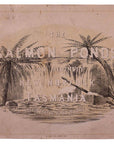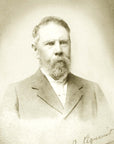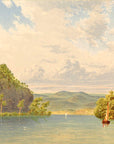



The Salmon Ponds and Vicinity - Piguenit
Some may know of, but never have seen, the rarest of all Australian fishing related books - ‘Salmon Ponds and Vicinity’ by William Charles Piguenit.
I only know of four copies. They reside in the Ballarat Art Gallery, the State Library of Tasmania, the Australian National Library and the National Gallery of Australia. In 2013 I visited the State Library in Tasmania and viewed and touched an original – with white gloves of course. It is holding up well for something produced nearly 150 years ago on poor quality paper. The printers of the day (1867) certainly didn’t worry about acid free paper, and the paper of these times was particularly poor quality. The 19th and 20th century were the worst times for paper longevity and some information about printing paper of that time is below – or visit the website for more detailed information: http://webworld.unesco.org/safeguarding/en/txt_grap.htm
If the component elements of a paper are relatively pure, it has good durability and quite long life expectancy. This is the case of most of the papers made up until the 19th century. Unfortunately, the appearance of wood pulp in the 19th century lead to a reduction in quality. Paper made with wood pulp purified more or less well according to the process applied - mechanical or chemical wood pulp - then sized with rosin (pine resin) in an acid medium stand up much less well to aging than most of the papers made previously. They yellow and rapidly lose their original flexibility. Many 19th and 20th century printed or manuscript documents kept in libraries and archives are today in very bad condition and can no longer be used by readers.
Stevens Publishing reproduced this large 51cm x 33cm work by Piguenit. The original has six plates, plus map, plus a page of text. As far as I can ascertain it has never been reproduced before.
This copy was limited to 55 copies, plus Publisher Proofs for the Tasmanian State Library, National Library, Inland Fisheries Service and Australian Fly Fishing Museum.
It has an additional leaf at the rear with details on Piguenit and will also include an extra set of the colour prints from within the book. These can be framed.
All books are individually bound in buckram and leather with a facsimile of the original cover set in. All pages will be printed on archival paper and will last indefinitely.
Countless hours have been spent ‘photoshopping’ the original scans to remove the foxing (spotting) and to bring them back to their glory of 1867. 1867 was just three years after trout were acclimatised to the southern hemisphere.
Although the original was lithograph printed we were not able to find a printer that can do that these days. This edition will be printed on the highest quality offset press and you will be amazed at how well these prints have come up.
Price is $690 plus postage.
In July 2007 an original sold for $69,900. It is now in the National Gallery. So you might be lucky and find a copy in a secondhand book store, but it is pretty unlikely.
The following details are from Jim Findlay’s book ‘Australian Fishing Books’.
Piguenit, W.C. and Henn, M.L. [1867]
The Salmon Ponds and Vicinity, New Norfolk, Tasmania. M.L. Henn: Hobart Town; oblong 37x52cm; [1] leaf; [6] tinted plates (a very faint yellow; each about 22x32cm) drawn on stone by W.C. Piguenit (pronounced as though the name ends in ‘et’, according to Clifford Craig in The Engravers of Van Diemen’s Land; p.109) and lithographed by M. L Henn; limp paper with a blue cloth spine. Clifford Craig notes (ibid., p.130) that in another copy the whole has been bound in stiff boards.
The plates comprise
Plate 1: The Derwent / Below New Norfolk;
Plate 2: Bennett’s Island / On the Derwent;
Plate 3: The Derwent / Below the Dry Creek;
Plate 4: The Derwent / Above the Dry Creek;
Plate 5: The Plenty / Near the Bend; and
Plate 6: The Salmon Ponds; and a map: The Plan of Salmon Ponds and Vicinity (lithograph, 26x24cm).
The engraved front wrapper has the view of the falls and the title within a tinted oval lithograph (24x38cm) headed The Salmon Ponds and Vicinity, New Norfolk, Tasmania, illustrated by W.C. Piguenit. Just three prints (Bennett’s Island on the Derwent, The Derwent, Below New Norfolk and The Derwent, Below the Dry Creek) are signed by Piguenit. M.L. Henn litho. is printed at the lower right below the image on each print except The Derwent, Below Dry Creek, where it is on the lower left, and the map. The one page of letterpress gives a short history of the successful introduction of salmon into Tasmania, including earlier attempts on the S. Curling (an utter failure), and the Beautiful Star, a small iron vessel intended for a steam collier, but then sent under sail to Tasmania.
In their W.C. Piguenit 1836–1914 Retrospective, Johannes and Brown note that the views presented in The Salmon Ponds were designed as illustrations of a large plan of the ponds, prepared by order of the Salmon Commissioners. However, the project did not eventuate, and instead the publication was a joint after-hours effort by Piguenit and Louis Henn, assistant lithographer in the Survey Department.
The Launceston Examiner (21 December 1867) welcomed the work: The Salmon Ponds—A series of views representing the salmon ponds and other spots in the vicinity, more or less connected with that establishment, has been prepared by Mr. W.C. Piguenit, a gentleman connected, we believe, with the Survey Department. The series will consist of six views, two of which we have seen, viz., “The Salmon Ponds,” and “Bennett’s Island, on the Derwent.” We cannot speak too highly of these pictures: there is a freedom about the drawing which indicates considerable skill on the part of the artist, whilst the lithographer has preserved the soft effect so peculiarly characteristic of chalk. These views would form pleasing souvenirs for distant friends at this season, and we should like to see other parts of the colony illustrated in a similar manner. Messrs. Walch Brothers and Birchall are the Publishers.
The Argus (Melbourne) was not impressed. This from February 28, 1868: A series of sketches by Mr. W. C. Piguenit, of the Salmon Ponds, vicinity New Norfolk, Tasmania, have been forwarded to us. The sketches are six in number, and comprise a view of the Derwent below New Norfolk, Bennett’s Island on the Derwent, the Derwent below the Dry Creek, the Derwent above the Dry Creek, the Plenty near the Bend, and the Salmon Ponds. They are rather mild specimens of art.
The Mercury of 17 December 1867 advertised the soon-to-be-released publication at one guinea (twenty-one shillings). It can’t have sold too well—W. Westcott, of Collins Street, Hobart, was advertising copies in his extensive catalogue in the Hobart Mercury of May 24, 1873, (The Salmon Ponds of Tasmania, illustrated by W. L. Piguenit, 6 large lithographic tints, oblong imperial folio) for the significantly reduced price of 7s. 6d.
The Salmon Ponds is very rare; perhaps the most elusive Australian item related to fish and fishing. Few copies are known to have survived. Just four copies have appeared at auction since the Craig copy sold in 1975 (now in the Ballarat Art Gallery): the Turnbull copy in 1981 and the Evans copy in 1989, which sold again in 2007 (25 July 2007, lot 579) as the Davidson copy. Finally, and illustrating the importance of condition, a less desirable copy (six lithographed plates, titled below the image, and lithographed plan of the Salmon Ponds and vicinity, the plates with later hand colouring, loose) was opened at $4,000 at the Australian Book Auctions sale in November 2012 but failed to attract a bid.
The Ballarat Art Gallery, the State Library of Tasmania, the Australian National Library and the National Gallery of Australia all have copies.
Jonathon Wantrup writes: Piguenit’s “Salmon Ponds” is an outstandingly rare Tasmanian illustrated book and an especially desirable work, if only because it appears to be the first plate book published by a native–born Australian artist. Unfortunately the very great rarity of the work will debar most collectors from acquiring this first and only topographical plate book published by an Australian during the first century of settlement.
In his 1995 book Tassie Trout Tips and Tactics Brian Cadle suggested a then current value of more than $15,000. The most recent copy to sell was offered at the third Rodney Davidson sale in July 2007 and achieved $69,900. It’s now in the National Gallery.
Auctions: Sotheby’s (London) £5/10/0 (1956; half morocco); Clifford Craig $1050 (1975); Leonard Joel Auctioneers in association with Gaston Renard $13,000 (1989) and Australian Book Auctions $69,900 (July 2007).
Ferguson 14166, Wantrup, 258.
1892: Reprinted in the Transactions of the Australasian Association for the Advancement of Science, Hobart, 1892 (according to the entry for Piguenit in the online edition of the Australian Dictionary of Biography at http://adbonline.anu.edu.au/biogs/A050490b.htm).
Mike Stevens




